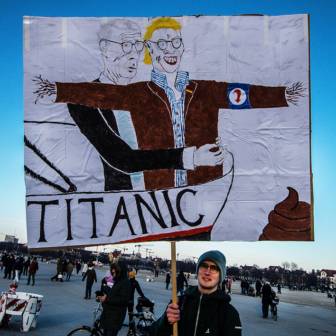OUR APPROACH to asylum seekers is woefully inadequate. I don’t necessarily mean the government’s asylum seeker policies, although those policies are certainly fraught with all sorts of problems. What I mean is how we, as a society, approach the issue of asylum seekers.
That approach is reflected in the public discourse on asylum seekers – or rather, the discourse on how to respond to their arrival. That discourse manifests itself not so much in what individual Australians think or say, as in the comparatively small number of positions that feature most prominently in public debate.
These positions could be located on a broad spectrum. At one end are the Tony Abbotts. They cry “Stop the boats!”, as if Australia’s survival were at stake. Some of them, including Mr Abbott himself, cry “Stop the Boats!” while knowing very well that the arrival of a few thousand irregular migrants, many of them refugees, should be, at worst, a minor inconvenience for a country as affluent as Australia. But while insinuating that the arrival of asylum seekers threatens national security and suburban lifestyles, they sow fears in the minds of others, such as the good citizens of Northam and Woodside, who believe their daughters won’t be safe and the local hospital will be understaffed if the government accommodates asylum seekers in their town.
At the other end of that spectrum, refugee advocates refer to asylum seekers as refugees as if the two terms were synonymous, and argue that Australia ought to grant protection to asylum seekers because they are deserving, that if only they were accorded protection they would make a valuable contribution to Australia.
Somewhere between those positions is that of the Gillard government. Or rather: those of the Gillard government, because Julia Gillard herself, who appears to empathise with the good citizens of Northam and Woodside, seems a long way from, say, former immigration minister Chris Evans, who brought a level-headedness to the issue not seen since the immigration ministers who served under Malcolm Fraser.
Please don’t get me wrong. I’m not saying that there haven’t been any thoughtful interventions in public debate. There have been many of them. But they are barely listened to outside the circle of those who live in ivory towers or who read the opinion pages of the Fairfax newspapers.
On 30 November, shadow immigration minister Scott Morrison gave a speech in Sydney, in which he reflected on some of the conundrums in Australia’s response to asylum seekers. Some of what he said was thoughtful and deserves further consideration. But the speech was reported in a way that gave the impression that all Morrison had been talking about was his idea for detention centres and extraterritorial processing in countries bordering Afghanistan. There may have been good reasons for the selective attention his speech received. For one, Morrison himself, when condensing the content of his speech to generate soundbites, focused on the issue of extraterritorial processing. Also, he does not exactly have a reputation for making thoughtful contributions to the debate; therefore only a few would have taken the trouble to read his speech.
I’ll come back to one of Mr Morrison’s points, but first I’d like to consider why the broader public discourse on asylum seekers in Australia is so shallow. It is shallow not least because it is uninformed, and I believe there are two main reasons why. The first has to do with the insularity inherent in Australian public discourse more generally. The problem of asylum seekers tends to be all about us – rather than about Australia’s obligations as a regional partner, its international legal obligations or its obligations as a rich nation that arguably has also benefited from the impoverishment of countries in the “developing world.” I won’t pursue these issues here, for I am mainly interested in the second reason: the lack of an informed historical perspective.
Because of such a lack, myths and misconceptions abound (such as the one that says: the majority of Vietnamese refugees resettled in Australia sought asylum after arriving on our shores as “boat people”). More often than not, however, those engaging in public debate believe that they don’t need to refer to the past at all.
Histories rarely provide suitable blueprints for present actions. Nor do they automatically prevent us from repeating past mistakes. But regardless of its capacity to lay the foundations for informed public debate, an awareness of the antecedents of Australia’s current approach to asylum seekers is useful for at least two reasons. First, and most importantly, histories – particularly those of pasts that are purportedly inconsequential – have the capacity to make us see the present in a new light. They make us stop and think. They allow us to recognise the present.
The other reason has been highlighted by some of the documents released by WikiLeaks. They have exposed much hypocrisy: policy-makers saying one thing in public and something altogether different to each other. Surprisingly often, their actions seem guided by their convictions, which are revealed not by what they say in public but by what they say to, for example, a trusted colleague – let’s say, somebody like Mark Arbib. When we’re trying to come to grips with current policy making, it is often difficult to find out what’s behind the smokescreen of media releases.
The job of getting behind that smokescreen is much easier with regard to policy-making in the past. After a while – thirty years in Australia – government files are opened to public scrutiny, allowing us to make informed surmises about motivations and rationales.
In his speech last month, Scott Morrison argued that the 1951 Refugee Convention was increasingly becoming an inadequate instrument for dealing with what he called “global people movement” and what I would call “forced migration”:
Global people movement will therefore become a greater problem in the years to come, but not necessarily for the reasons as defined in the UN Refugee Convention and Protocol.
The Convention is designed to provide relief for an individual with a well founded fear of persecution. It does not provide relief for people leaving a war zone, health epidemic, famine, natural disaster or economic collapse.
Interestingly, only 27% of Vietnamese seeking asylum status under the Comprehensive Plan of Action were successful in their asylum claims.
A person may not be a refugee according to the Convention, however, their home country may still, at a general level, be unsafe and expose them to a more general mortal risk.
The absence of other instruments dealing with these more general risks forcing people to move are likely to lead to the Refugee Convention being abused as a surrogate – with claims being confected to attract protection.
The UNHCR must therefore re-look at its mandate, in concert with its parent organisation and signatory countries to rethink what should be its greater focus in the years ahead.
It could be useful to have an informed debate about this idea. But then we would need first to know more about the 1951 Convention – and its alternatives.
ONE of the myths and misconceptions about the 1951 Convention is that it was the direct result of the lessons learned from what happened in Nazi Germany. But the main problem for those persecuted in Nazi Germany was not being deported from countries of refuge but being admitted to them in the first place. The 1951 Convention does not really concern itself with that issue. It is for people who are “outside of their country of origin.” It was not a response to numerous cases of individuals trying to flee persecution in country A by knocking on the door of country B, but to their already being in country B.
The United Nations High Commissioner for Refugees, or UNHCR, was the successor organisation to the IRO, the International Refugee Organization, set up in 1946, which in itself was the successor to the UNRRA, the United Nations Relief and Rehabilitation Administration, set up in 1943. Both the IRO and the UNRRA were agencies created specifically to deal with the displacement of millions of people in the course of the second world war. While the UNRRA organised the movement of displaced people from country B back to country A, the IRO facilitated their passage to country C. The UNHCR took over that task when the IRO ceased operating.
Most of the people who fell within the brief of the UNHCR in 1950, when the organisation was established, were living in refugee camps in Germany, Austria and Italy. They were the refugees that the architects of the Convention primarily had in mind. Today’s equivalent of the “displaced persons,” or DPs, of the immediate postwar years are the forced migrants stuck in UNHCR-administered refugee camps, often for many years; the notorious Kakuma and Dadaab refugee camps in Kenya are today’s Föhrenwald and Wildflecken, the large DP camps in the late 1940s and 1950s.
The experience of hundreds of thousands of people unsuccessfully trying to flee Nazi Germany informed the architects of another international instrument, the 1948 Universal Declaration of Human Rights. Its article 14 states: “Everyone has the right to seek and to enjoy in other countries asylum from persecution.” But it is the 1947 version of the Declaration, which was drafted by the United Nations Human Rights Commission, that reflects most obviously the original intent of its architects: “Everyone has the right to seek and be granted in other countries asylum from persecution.” Hersch Lauterpacht, who later became a judge of the International Court of Justice, commented that the formula adopted by the General Assembly in 1948 was “artificial to the point of flippancy,” and that it would have been “more consistent with the dignity” of the Declaration if Article 14 had been left out altogether.
The architects of the Universal Declaration envisaged that its article 14 would be fleshed out in a separate instrument. The perceived need for such an instrument was not substantially affected by the 1951 Refugee Convention.
During the 1950s, the right to asylum continued to preoccupy the Human Rights Commission. In 1957, France (represented at the time by René Cassin, who had earlier been one of the driving forces behind the Universal Declaration of Human Rights) submitted a draft declaration on the right of asylum. The first two articles of that document read as follows:
1. Responsibility for granting asylum to persons requesting it shall lie with the international community as represented by the United Nations.
2. Every person whose life, physical integrity or liberty is threatened, in violation of the principles of the Universal Declaration of Human Rights, shall be regarded as entitled to seek asylum.
Article 5 of the French draft reads in part: “No one shall be subjected to measures, such as expulsion, return or rejection at the frontier, which would result in compelling him to return to or remain in a territory where his life, physical integrity or liberty would be threatened, in violation of the principles of the Universal Declaration of Human Rights.” The response was lukewarm. Most governments thought that the text went too far. Only a small minority of member states – Spain, Yugoslavia and the Netherlands – conceived of the Declaration primarily as an instrument to enshrine the rights of individuals and made suggestions that went further than the French draft.
Over the next ten years, a succession of committees worked on the draft declaration. Eventually, on 14 December 1967, the General Assembly unanimously adopted the Declaration on Territorial Asylum. It makes no mention of the idea that asylum is granted by the United Nations itself, rather than by individual member states. The right not to be rejected at the frontier has been qualified: exceptions can be made “for overriding reasons of national security or in order to safeguard the population, as in the case of a mass influx of persons.”
Between 1974 and 1977, the United Nations once more discussed the right of asylum. This time the initiative came from the UNHCR, which aimed for a Convention on Territorial Asylum to complement the 1951 Refugee Convention. The idea was shelved when it became apparent that no agreement could be reached. There were no further attempts to revive the discussions, and the right of asylum has disappeared so far from view that the 1967 Declaration is barely remembered today.
What was Australia’s position? In 1948, Australia had joined forces with the Soviet Union in opposing the earlier draft of Article 14 of the Universal Declaration. It was perhaps unsurprising that when the French first presented a draft text for a declaration on asylum, the Australian Mission to the UN was instructed to point out that the proposal amounted to a “substantial inroad on national sovereignty” and that it would therefore be unacceptable to Australia.
As the wording of the draft changed, so did the attitude of the Australian government. Rather than rejecting a declaration outright, as they had done initially, Australian negotiators played an important role in watering down its provisions.
In 1960, the acting secretary of the immigration department listed several reasons why the Australian delegation ought to push for a non-committal wording. He thought that the draft, which then still bore traces of the original French version, was unacceptable to Australia. He recommended to the Australian delegation that they put forward an argument that has often been used to defend Australia’s asylum seeker policies: “We hope Australia’s proud record in the matter of resettlement of and assistance to refugees since the end of World War II should suffice to stifle any criticism in the General Assembly, of our present reluctance to accept the draft declaration on the Right of Asylum.”
Right up to the vote in the General Assembly, elements of the Australian government remained critical of the Declaration. The Department of Territories, in particular, feared that the Declaration would encourage asylum requests from West Papuans crossing into the Australian Territory of Papua and New Guinea. Earlier, the attorney-general’s department had raised two issues. First, while in Australia’s view “a Declaration would not have binding force,” that view might not be shared by other countries. Second, even if all countries agreed that a Declaration were merely a recommendation, “an Australian vote in favour… could form a basis for criticism if Australian practice were to depart from the Declaration.” Declaration or no Declaration, the Australian government maintained that it had the right to deport asylum seekers whenever it wished to do so. While voting for the Declaration in the General Assembly, the government knew that Australian practice would depart from that recommended in the Declaration.
By the time the right of asylum was back on the UN’s agenda, Labor had replaced the conservative coalition. The Whitlam government wanted to be seen internationally as a champion of human rights, including the right to asylum, and some ministers genuinely believed that the time had come to go further than the 1967 Declaration. Foreign affairs minister Don Willesee thought that “Australia, as an enlightened country, a middle power and one of the few countries of immigration, could well show a lead to others in regard to territorial asylum.” His department could point to the generous application of Australia’s asylum seeker policy – very often, asylum seekers, while being refused asylum, were nevertheless given permanent visas. At the same time, though, Gough Whitlam decided that in the event Vietnamese refugees were to reach Australia by boat, they would be disembarked “into custody” in order to be able to return them to their boat “for the purpose of departing them from Australia.” Of course, by the time those “boat people” arrived in Australia, Malcolm Fraser had replaced Whitlam, so we don’t know exactly how Whitlam’s instructions would have been implemented.
Under Fraser, Australian negotiators were advised that the government “will wish to retain its discretion to determine ultimately who can enter into Australian territory and under what conditions they remain.” There was nothing new about that sentiment – variations of it have guided Australian asylum seeker policy for many years, including later, of course, when John Howard uttered his infamous line, “We have the right to decide who comes to this country, and the circumstances in which they come.”
THIS is one of those histories I’m fond of. In some ways it doesn’t seem immediately relevant to what’s happening now, but it can help us to recognise the provisional nature of the status quo and, at times, its absurdities. Mind you, it is more relevant than it might seem. Australia still has an asylum seeker policy that is substantially different from its refugee policy. The former is administered by Foreign Affairs, whereas the latter is the responsibility of Immigration. In fact, Australia still has a visa category for those who are granted asylum rather than protection.
What this history may help us to recognise is the fact that there is an important difference between those who come to seek asylum, and those who are invited to come here to enjoy asylum. In my view, this history could provide ammunition for the argument that asylum – “the protection which a state grants … to a person who comes to seek it,” according to a definition coined by the Institute of International Law in 1950 – should be the domain of the attorney-general rather than the immigration minister.
I hope that histories such as this one provoke curiosity – not just about the past but also about the peculiarities of the status quo. For such histories may make the present appear to be a little less self-evident. And of course, the more we understand the present to be contingent and provisional, the more we can imagine alternatives to it. •




